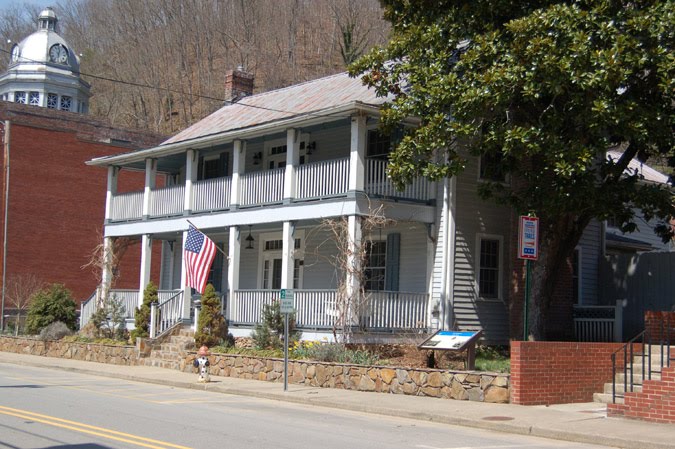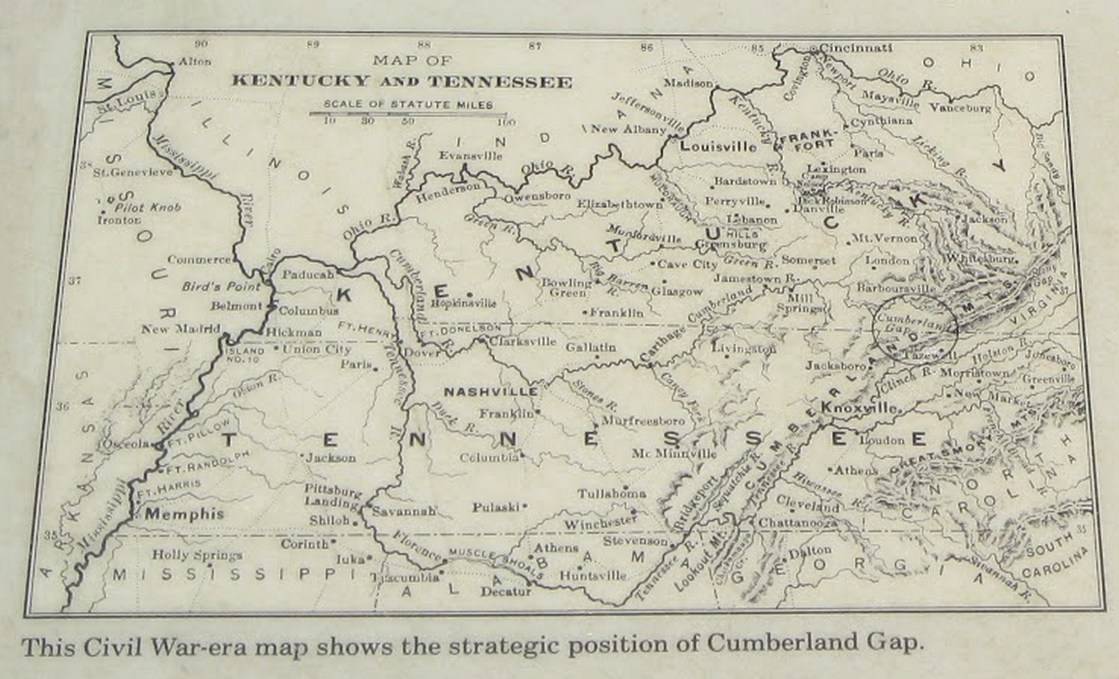|
64th North Carolina Infantry Regiment (Allen's)
| (Courtesy michaelchardy.blogspot.com) |

|
| Colonel Lawrence Allen home in Marshall, NC |
64th Infantry Regiment organized during the summer of 1862 and
was anticipated to be a legion containing thirteen companies of infantry and three of cavalry. Subsequently, the command was
reduced to ten companies and designated the 64th North Carolina Infantry Regiment. Its members were recruited predominately
from the Western North Carolina counties of Madison, Henderson and Polk. The unit served in North Carolina and East Tennessee; its service proved invaluable in the defense of vital and strategic Saltworks and railroads. In early 1863 the 64th was associated with the infamous Shelton Laurel Massacre. In July 1863 the unit was assigned to General Gracie's Brigade and stationed in the Cumberland
Gap. While in the Cumberland
Gap in September 1863, a fraction of the regiment was surrendered. The
records reflect that 288 men of the 64th were prisoners at Camp Douglas. The regiment continued fighting
with about 100 effectives, serving under Generals Breckinridge (14th Vice President of the United States), Vaughn, and Williams in East
Tennessee. Together, the 58th, 62nd, 64th, and 69th (Thomas' Legion) North Carolina Regiments fought the enemy in East Tennessee and in western
North Carolina. It became part of Colonel John B. Palmer's Brigade at Asheville in March 1865 and subsequently disbanded
near the French Broad River. The unit's commanders were Colonel Lawrence M. Allen, Lieutenant Colonels William N. Garrett and J. A. Keith, and Major Thomas P.
Jones. Allen's Regiment was also known for its high desertion rate.
| Map of 64th NC Troops at Cumberland Gap |

|
| 64th North Carolina suffered under the leadership of General Frazer while assigned to Cumberland Gap |
Advance to:
Editor's Pick:
The Secret of War: A Dramatic History of Civil War Crime in Western North Carolina,
by Terrell T. Garren. Description: Civil War crime in western North Carolina is the subject of The Secret of War, by Terrell T. Garren. Based on the true-life
experience of Delia Russell Youngblood, the great-grandmother of the author, the book "captures what the Civil War was like
in the mountains and throughout the south." After hearing his great-grandmother's story, Garren spent nearly fifteen years
researching this story in particular and the Civil War history of western North
Carolina in general. It is the story of Joseph Youngblood and Delia Russell of Hoopers Creek in Henderson County, North Carolina. Continued
below…
The reader will follow Joseph
through his enlistment as a part of Company H, the "Cane Creek Rifles," of the 25th North Carolina Infantry Regiment to the
Battle of Malvern Hill, Virginia, and to battle in Sharpsburg, Maryland, where
he was captured. Taken to the Union Camp Morton in Indianapolis, Indiana,
he finally escapes and make his way down the Ohio and Mississippi
rivers into Mississippi. Attempting to make his way back
to North Carolina, he is in Dalton, Georgia, in May of 1864 when fourteen Confederate soldiers, including a brother,
are executed for "desertion." Ultimately, being recaptured, he goes back to Camp
Morton until the end of the war. Told with historical accuracy, names,
battles, and places in this story are true to fact. Readers will recognize place names in Henderson,
Jackson, Haywood, Cherokee, Transylvania, Clay, Macon, and Buncombe Counties in North
Carolina. Family names mentioned include Fletcher, Carland, Lewis, Bishop, Bryson, Freeman, Henderson,
Fowler, Whitaker, Wheeler, Summey, Russell, Barnwell, Ward, Lanning, Hammond, Garren, Youngblood, and Blake. What sets this book apart from many, however, is the story of what happened to the women left
behind at home. The story reveals how the lowest criminal element found its way into the Union Army. Many mountain men motivated
by greed and an awareness of the demise of Confederate authority signed up with no interest in any cause but their own. Union
officers who enter the picture include Generals George Stoneman, Alavan C. Gillem, and William J. Palmer. Palmer enters the
story late but emerges as a man of genuine integrity and selfless bravery opposed to and fighting this element in his own
army. About the Author: Terrell T. Garren is an eighth generation western North Carolinian. He was born in Asheville, North Carolina, in 1951. He earned his B.S. and
M.A. degrees from Western Carolina University in Cullowhee, North
Carolina. A resident of Henderson County, North Carolina, he has been a commercial writer for twenty years.
Dr. Newton Smith of Western
Carolina University says, "The Secret of War" is that rare historical novel that captures both the romance and the grit and
gore of war on the home front without distorting the history. It is about time someone did the story of the Civil War in the
southern mountains right."
Rob Neufeld, writing in
the Asheville (NC) Citizen-Times, has said the book "is a must read" and "as a contribution to our understanding of the most
disturbing passage in our history, it is indelible." He further writes, "Fiction? It really happened; and, if it hadn't, the
author wouldn't be around to tell it....Although Garren has written fiction, he wants you to treat it as history. After all,
at the back of his book, he provides an index."
Recommended Reading: Mountain Partisans: Guerrilla Warfare in the Southern Appalachians,
1861-1865 (Hardcover). Description: This is the story of a civil war within the Civil
War. Some highlanders in Southern Appalachia opposed the Confederacy, especially when the
South's conscription and impressment policies began to cause severe hardships. Deserters from the Rebel army hid in the mountains
and formed guerrilla bands that terrorized unprotected Confederate homesteads. Violence escalated as Rebel guerrillas fought
back. The conflict soon took on some of the ugliest aspects of class warfare between poorer mountaineers, and the more well-to-do
mountain property owners, who supported the Rebels. Continued below...
Mountain
Partisans penetrates the shadowy world of Union and Confederate guerrillas, describes their leaders and bloody activities,
and explains their effect on the Civil War and the culture of Appalachia. Although it did not alter the outcome of the war, guerrilla conflict affected
the way the war was fought. The Union army's experience with guerrilla warfare in the mountains influenced the North's adoption
of "hard war" as a strategy used against the South in the last two years of the war and helped shape the army's attitude toward
Southern civilians. Partisan warfare in Southern Appalachia left a legacy of self-imposed
isolation and distrust of outsiders. Wartime hatreds contributed to a climate of feuds and extralegal vigilantism.
Recommended Reading:
Bushwhackers, The Civil War in North Carolina:
The Mountains (338 pages). Description: Trotter's book (which could have been titled "Murder, Mayhem, and Mountain Madness") is an epic backdrop
for the most horrific murdering, plundering and pillaging of the mountain communities of western North Carolina during the
state’s darkest hour—the American Civil War. Commonly referred to as Southern Appalachia, the North
Carolina and East Tennessee mountains witnessed divided loyalties in its bushwhackers
and guerrilla units. These so-called “bushwhackers” even used the conflict to settle old feuds and scores, which,
in some cases, continued well after the war ended. Continued below...
Some bushwhackers
were highly organized ‘fighting guerrilla units’ while others were a motley group of deserters and outliers,
and, since most of them were residents of the region, they were familiar with the terrain and made for a “very formidable
foe.” In this work, Trotter does a great job on covering the many facets of the bushwhackers, including their: battles,
skirmishes, raids, activities, motives, the outcome, and even the aftermath. This book is also a great source for tracing
ancestors during the Civil War; a must have for the family researcher of Southern Appalachia.
Recommended Viewing: The Civil War - A Film by Ken Burns. Review: The
Civil War - A Film by Ken Burns is the most successful public-television miniseries in American history. The 11-hour Civil War didn't just captivate a nation,
reteaching to us our history in narrative terms; it actually also invented a new film language taken from its creator. When
people describe documentaries using the "Ken Burns approach," its style is understood: voice-over narrators reading letters
and documents dramatically and stating the writer's name at their conclusion, fresh live footage of places juxtaposed with
still images (photographs, paintings, maps, prints), anecdotal interviews, and romantic musical scores taken from the era
he depicts. Continued below...
The Civil War uses all of these devices to evoke atmosphere and resurrect an event that many knew
only from stale history books. While Burns is a historian, a researcher, and a documentarian, he's above all a gifted storyteller,
and it's his narrative powers that give this chronicle its beauty, overwhelming emotion, and devastating horror. Using the
words of old letters, eloquently read by a variety of celebrities, the stories of historians like Shelby Foote and rare, stained
photos, Burns allows us not only to relearn and finally understand our history, but also to feel and experience it. "Hailed
as a film masterpiece and landmark in historical storytelling." "[S]hould be a requirement for every
student."
Recommended Reading: The Life of Johnny Reb: The Common Soldier of the Confederacy (444
pages) (Louisiana State University Press) (Updated edition: November 2007) Description: The
Life of Johnny Reb does not merely describe the battles and skirmishes fought by the Confederate foot soldier. Rather,
it provides an intimate history of a soldier's daily life--the songs he sang, the foods he ate, the hopes and fears he experienced,
the reasons he fought. Wiley examined countless letters, diaries, newspaper accounts, and official records to construct this
frequently poignant, sometimes humorous account of the life of Johnny Reb. In a new foreword for this updated edition, Civil
War expert James I. Robertson, Jr., explores the exemplary career of Bell Irvin Wiley, who championed the common folk, whom
he saw as ensnared in the great conflict of the 1860s. Continued below...
About Johnny Reb:
"A Civil War classic."--Florida Historical Quarterly
"This book deserves to be on the shelf of every Civil War modeler and enthusiast."--Model
Retailer
"[Wiley] has painted with skill a picture of the life of the Confederate
private. . . . It is a picture that is not only by far the most complete we have ever had but perhaps the best of its kind
we ever shall have."--Saturday Review of Literature
Recommended Reading: Confederate
Military History Of North Carolina: North Carolina
In The Civil War, 1861-1865. Description:
The author, Prof. D. H. Hill, Jr., was the son of Lieutenant General Daniel Harvey Hill (North
Carolina produced only two lieutenant generals and it was the second highest rank in the army)
and his mother was General “Stonewall” Jackson’s wife's sister. In Confederate
Military History Of North Carolina, Hill discusses North Carolina’s massive task of preparing and mobilizing
for the conflict; the many regiments and battalions recruited from the Old North State; as well as the state's numerous
contributions during the war. Continued below...
During Hill's Tar Heel State
study, the reader begins with interesting and thought-provoking statistical data regarding the 125,000 "Old North State"
soldiers that fought during the course of the war and the 40,000 that perished. Hill advances with the
Fighting Tar Heels to the first battle at Bethel, through numerous bloody campaigns
and battles--including North Carolina’s contributions at the "High Watermark" at Gettysburg--and concludes with Lee's surrender at Appomattox.
Highly recommended!
Sources: Official Records of the Union and Confederate Armies; Walter Clark,
Histories of the Several Regiments and Battalions from North Carolina in the Great War 1861-1865; National Park Service: American
Civil War; National Park Service: Soldiers and Sailors System; Weymouth T. Jordan and Louis H. Manarin, North Carolina Troops,
1861-1865; and D. H. Hill, Confederate Military History Of North Carolina: North Carolina In The Civil War, 1861-1865.
|

